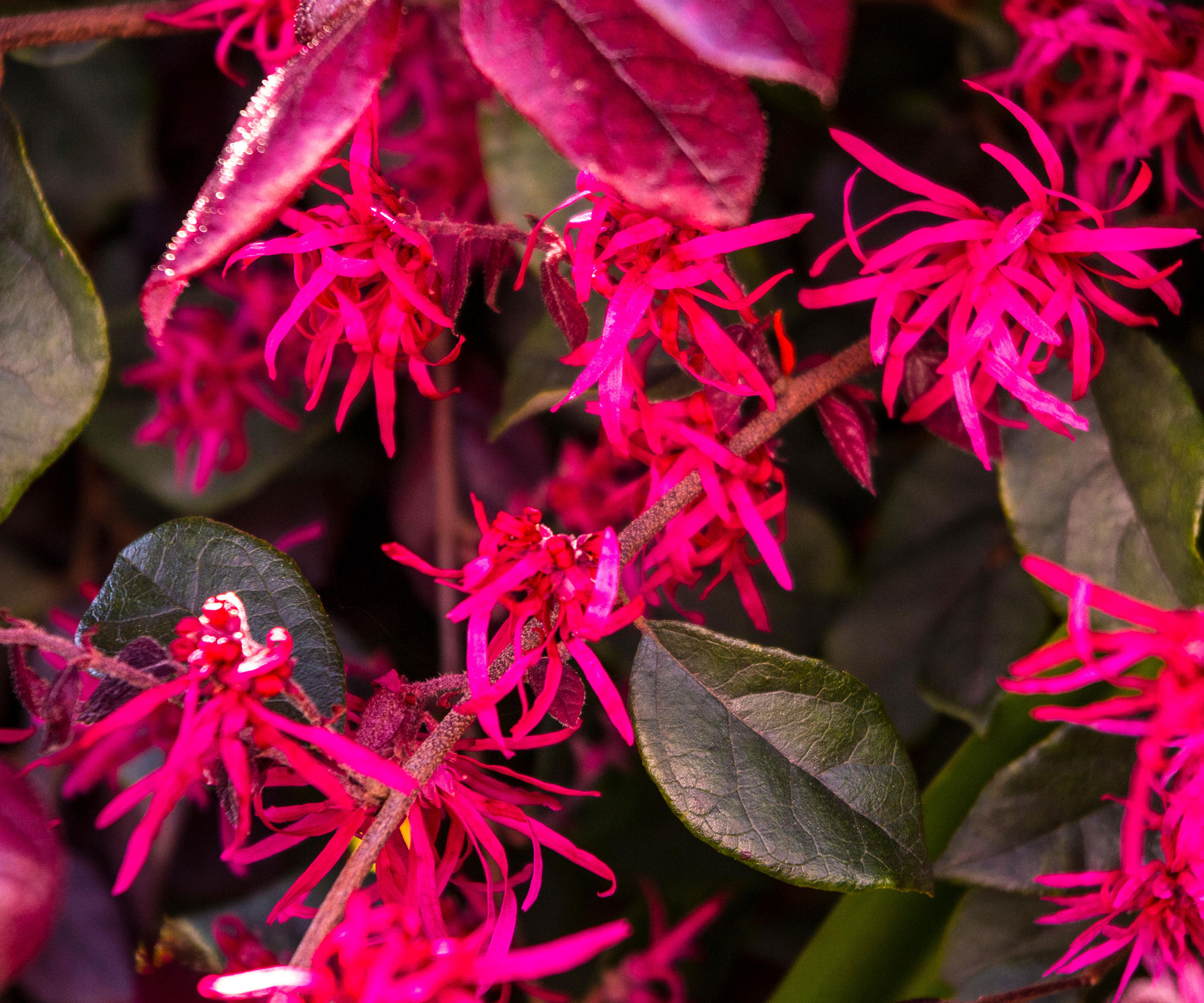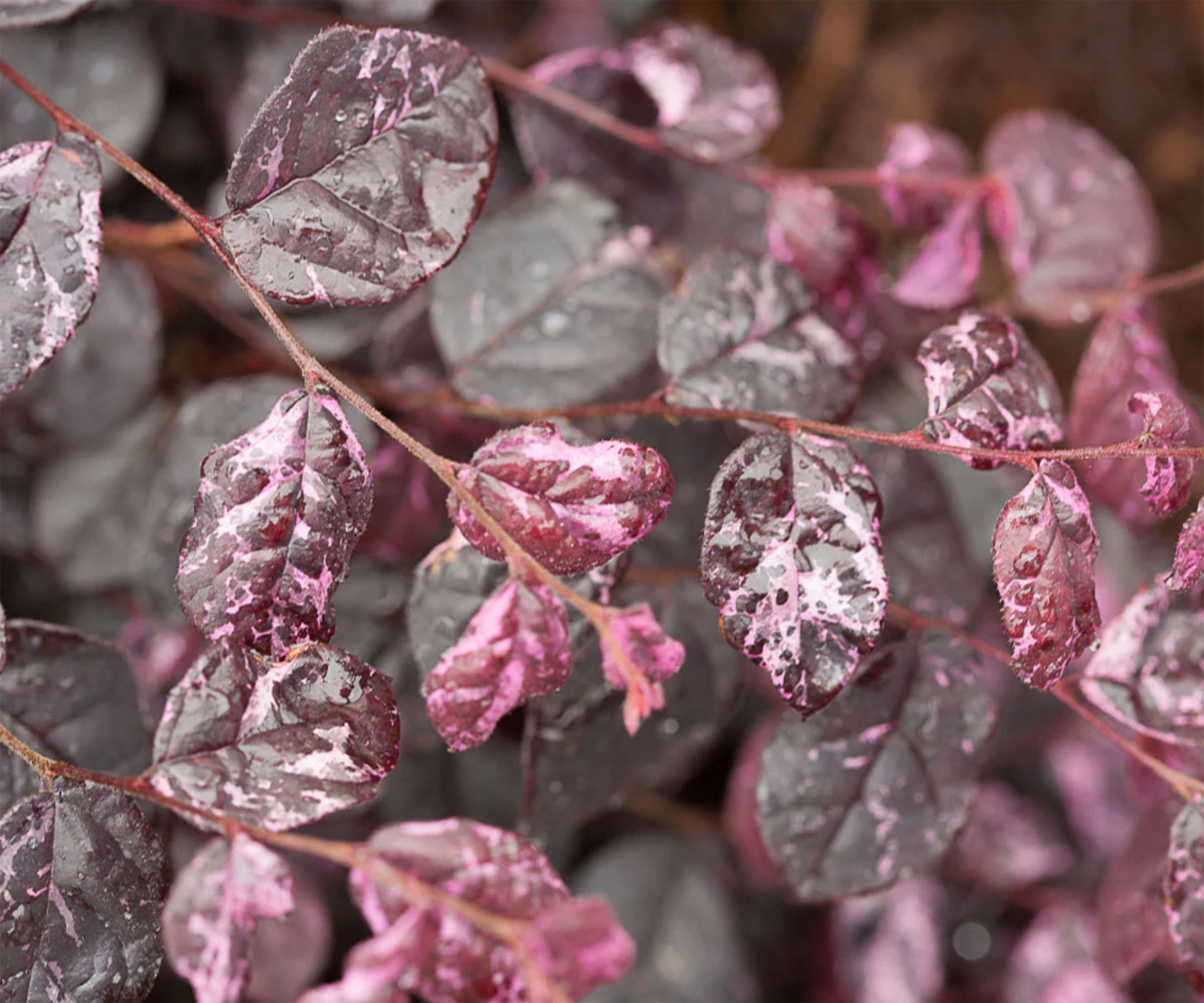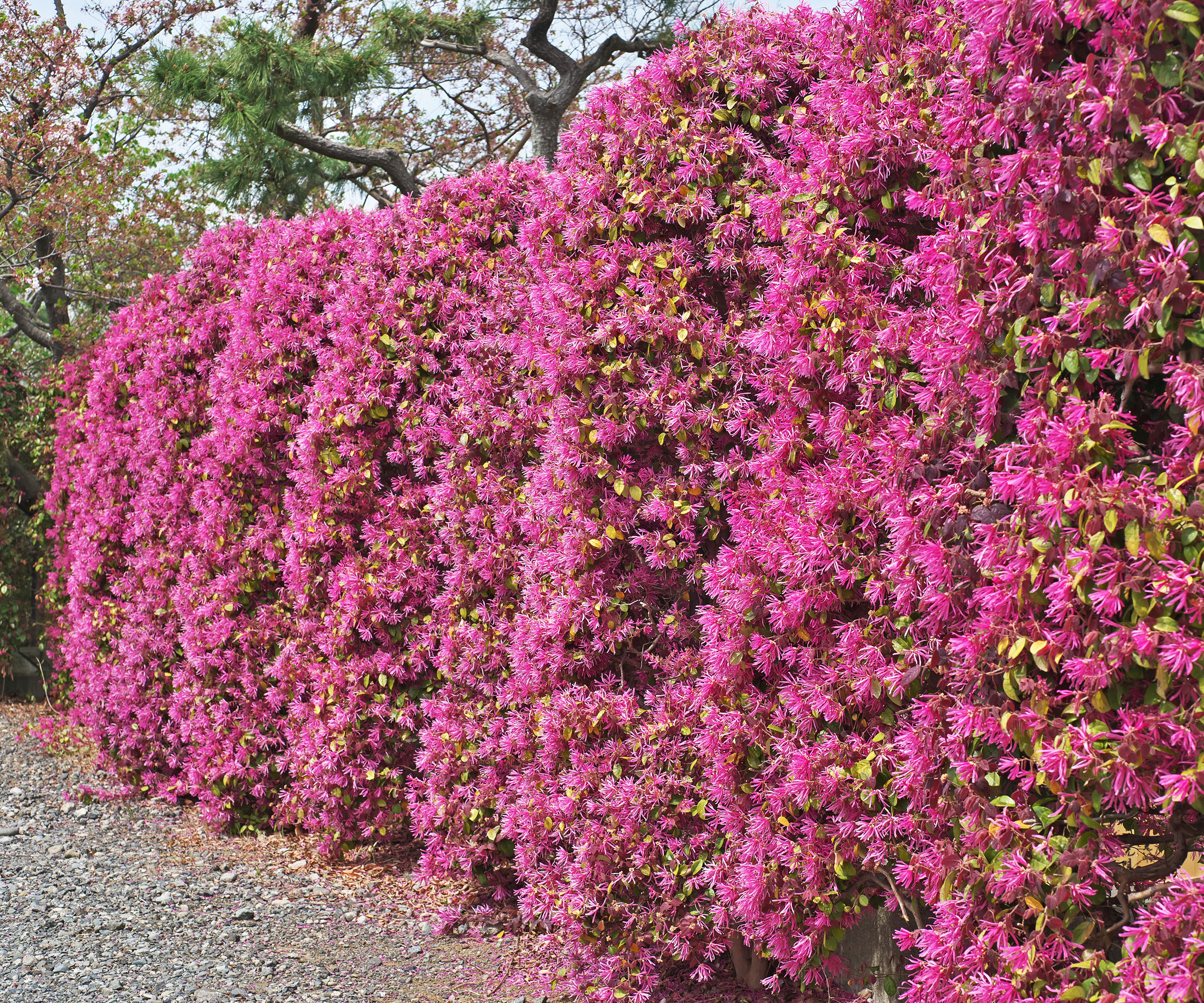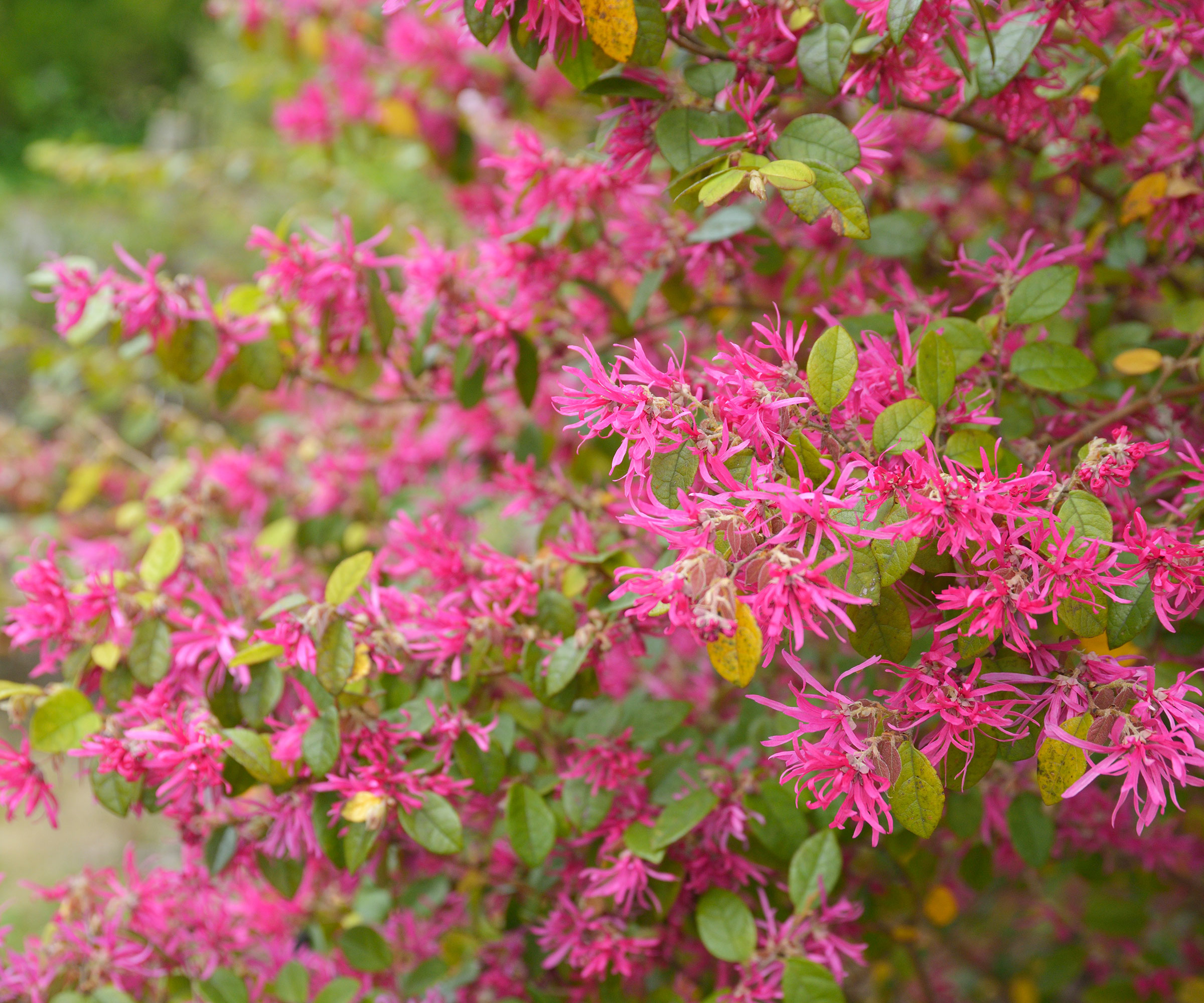Loropetalum care and growing guide – expert tips for these flowering evergreens
With their stunning spring flowers and striking foliage, drought-tolerant loropetalums are a worthy addition to your yard


Loropetalum, sometimes known as Chinese fringe flower, is a superb, spring flowering, lightly scented evergreen shrub for milder climates. Reliable, adaptable and impressively drought tolerant, loropetalum is a dependable choice for gardeners in zone 7 and above.
Developing into a rounded or vase-shaped evergreen shrub or small tree, the neat dark green foliage is gray on the undersides and, in spring, clusters of frilly narrow-petalled flowers appear at the leaf joints. Flower color ranges from deep red, through a range of red and salmon and rose pink shades to a slightly creamy white.
In 1990 two varieties with reddish or purple-bronze foliage were introduced from China and plant breeders have quickly added their leaf color to create a wide range of exciting new varieties. The result has been rapidly growing popularity across the country, and loropetalums are now among the most popular evergreen shrubs in any gardens where the soil is suitable and the winters are not too cold.

Foliage and flower color are key features of loropetalum shrubs
Loropetalums: key facts
- Plant type: Evergreen shrub
- Mature size: 1-15ft
- Soil type: Well drained, but generally adaptable. Hates chalk
- Soil pH: Neutral to acid
- Light: Full sun, part shade
- Time of year to plant: Spring, fall
- Flowering time: Spring
- Flower color: Red, pink, white, creamy yellow
- Hardiness zones: USDA Z7
- Scientific name: Loropetalum
- Common name: Chinese fringe flower
Two kinds of loropetalum
If you're a fan of spring-flowering shrubs, it's worth adding loropetalums to your planting list. 'If prescriptions could be written for perfect garden plants, this species would come close to filling the order,' says Georgia’s Michael Dirr in his Encyclopedia of Trees and Shrubs (available from Amazon).
When choosing one for your yard, they can considered in two ways: by the size of mature plants and by leaf color.
- Loropetalums by size These drought-tolerant shrubs range in size at maturity from 12in to 15ft, so variety choice is crucial. Some of the smallest varieties develop a spreading habit so make good ground cover plants, while others are more bushy and make good options for container gardening ideas. Stepping up in size there are some fine varieties that make excellent foundation plants and whose purple foliage associates well with junipers and other low conifers. Specimen plants, combining richly colored foliage for many months with a dazzling burst of pink spring flowers work very well, while the largest loropetalums develop a vase shape and mature into elegant small trees.
- Loropetalums by leaf color For the first hundred years that we grew loropetalums, all the varieties had green foliage. The neat, oval, evergreen leaves are lightly veined on the upper surface and grayish below. Then when those two dark-leaved varieties arrived in the US from China, plant breeders quickly developed new varieties, selecting those that retained the purple foliage coloring for the longest time and matching it with the full range of flower colors.
Choosing the right size loropetalum for your yard
This really is a case where remembering the old cliché 'right plant, right place' is important.
The smallest varieties make colorful spreading ground cover. These include Jazz Hands Mini ('Beni Hime') (12inx3ft), available from Amazon, with deep purple foliage and magenta pink flowers, as well as the slightly larger ‘Crimson Fire’ (18inx3ft), available from Fast Growing Trees.
Design expertise in your inbox – from inspiring decorating ideas and beautiful celebrity homes to practical gardening advice and shopping round-ups.
For foundation planting it pays to step up in size and consider Ever Red ('Chang Nian Hong') (4x6ft), available at Fast Growing Trees, with red foliage and red flowers. Or Jazz Hands White ('Hakuou') (4x4ft), with white flowers against fresh green foliage.
As a specimen shrub then a little larger works better, consider ‘Ruby’ (6-8x6-8ft), available from Perfect Plants, with reddish purple leaves, pink flowers. Jazz Hands Bold ('Kurenai Daiou'), (6x6ft), available from Monrovia, has unusually large purple leaves and pink flowers.
Then as a large shrub, a privacy shrub, or a tree for a small garden there’s ‘Little Rose Dawn’ (10ft) or the very tall ‘Zhuzhou Fuchsia’ (15ft), available from Amazon.

Loropetalum Jazz Hands Bold
The best loropetalums for foliage color
The green foliage of so many loropetalums is an attractive color, and effectively sets off the flowers, but now we have varieties with rich ruby red or purple foliage. In some the coloring fades as summer develops, in other it is retained for longer.
Perhaps the variety with the darkest of all foliage is Jazz Hands Mini ('Beni Hime') (12in), with deepest purple, almost black, foliage all year and magenta pink flowers and this is matched by the foliage of the taller Ever Red (‘Chian Nian Hong’) (4ft), available from Fast Growing Trees, that keeps its color well in all conditions.
The leaves of ‘Zhuzhou Fuchsia’ are deep purple red, and a little glossy, and this variety is hardier than many dark leaved varieties. There are also a few variegated varieties including Jazz Hands Variegated ('Irodori'), available from Fast Growing Trees, with new leaves splashed in white and pink that become purple later in the season. Jazz Hands Night Moves (‘Suzuki’), available from Nature Hills, has blushed white flowers set against purple foliage that develops green and white speckles later in the season.
‘Snow Panda’ has sage-green leaves and white flowers while Emerald Snow (‘Shang-white’) has lime green new growth and white flowers.

Where to grow loropetalums
'Loropetalum is an evergreen shrub that looks good in just about any Florida garden...,' says the University of Florida Institute of Food & Agricultural Sciences (IFAS). 'This versatile shrub works equally well in foundation plantings and in landscape beds.'
Loropetalums are more adaptable than most evergreen shrubs although it is important to remember that they cannot take cold winters, and will not thrive in areas that are colder than USDA zone 7. Zone 8 is usually preferable.
They will grow well in full sun or in part shade, acid or neutral soil types high in organic matter is preferred and once established loropetalums will tolerate drought but will not tolerate permanently wet conditions. The red foliage coloring is enhanced in rich, fertile soil and when the plants are not parched.
Fringe flower also makes a good informal hedging plant – just make sure you choose the variety according to how tall you need your hedge to be.

Loropetalums can be used to create a pretty flowering hedge
When to plant loropetalums
Spring or fall are the best planting times as the plants will then avoid the stresses of having to deal with summer heat or winter cold soon after planting and before the plants have settled in and become established.
Loropetalums prefer soil with plenty of organic matter, so it always pays to amend the soil with an acid material such as composted pine bark, or any material recommended for rhododendrons, before planting.
After planting, water in well with a liquid rhododendron feed, such as Miracle-Gro LiquaFeed from Amazon. Mulching with weed-free and lime-free types of mulch such as bark, or composted pine bark is also recommended.
Ensure that your newly planted loropetalum does not dry out in its first year.

Loropetalums will grow well in fairly acid soils
Care tips
Fringe flowers benefit from annual feeding, annual renewal of their mulch and often benefit from annual pruning.
Feed every year after flowering, using a feed formulated for rhododendrons and other lime-hating, acid-loving shrubs. If necessary, renew the mulch at the same time, but be sure not to mound the mulch against the stems.
After flowering is also the best time to prune your loropetalum, although pruning is not always necessary. If your plant is developing a natural looking balanced shape without pruning, then allow it to continue unpruned.
If your fringe flower is looking uneven in its shape, if you have a loropetalum hedge that you need to keep dense for garden screening or privacy, or if it is simply becoming too large for its situation, then pruning will help.
These are landscaping shrubs that are very tolerant of pruning so can be trimmed or thinned lightly, shaped carefully or they can be cut back hard. As long as the roots do not dry out immediately after pruning, they will respond well.

Prune after flowering to keep your shrub in shape
Propagating loropetalums
Loropetalums can be propagated by taking plant cuttings in summer. Here's the easiest method to follow.
- Using clean and sharp pruners, snip off shoots about 6in long from the ends of the shoots. Try to choose shoots that are soft at the tips and woodier, twiggier, at the base. Trim the base of the stem just below a leaf, then nip off the leaves on the bottom half of your cutting. Remember to clean your garden tools after use to prevent the potential spread of diseases too.
- Make a 50:50 mix of seed starting mix and perlite or grit and use it to fill a 4-5in diameter pot. Tap the base of the pot on the table to settle the mix.
- Dip the base of each cutting in hormone rooting gel and stick the cutting in the mix up to its lowest leaves. Water carefully until water is draining from the base of the pot.
- When the surplus water has drained away, stand the pot in a clear plastic bag, and tie the top. Leave it in a bright but cool place, add a little more water if the mix is drying out and, later in the summer, the cuttings should have rooted and roots will emerge from the drainage holes in the pot.
- Move the plants to individual pots for winter and plant in the spring.
Problems and how to solve them
Fringe flowers are relatively trouble free and low-maintenance shrubs, but two problems are sometimes encountered. All varieties of loropetalum prefer well-drained soils but if drainage is poor, and the roots stay wet for long periods – especially in winter – then this may encourage root rots. Confusingly, the plant may wilt because its roots have rotted and so cannot take up water.
Some loropetalums have also been troubled by Loropetalum Decline, in particular the very popular variety ‘Ruby’. Plants seem generally unhealthy, new growth is stunted. This is caused by a deficiency in micronutrients, especially copper, which is not easy for the home gardener to remedy.
Other varieties are rarely troubled by this problem, so the simplest approach is to remove your ailing plant and start again with a different variety – preferably in another site.
FAQs
Are loropetalums deer resistant?
Reports vary but, in general, it seems that fringe flowers are not a deer’s first choice for browsing. The flowers are fragrant and the foliage has a bitter taste, which is a definite deterrent and helps to make them a deer resistant plant, but when food is scarce deer may browse on loropetalum until they can find something more palatable.
Can I grow a loropetalum in a container on my deck?
Yes, fringe flowers make good plants for pots, although it is important to choose varieties that mature to a manageable size, that are attractive all year round, and to plant them in the correct soil mix.
Dwarf- and medium-sized varieties are ideal, for obvious reasons – some varieties will grow to 15ft and so are not suitable for container growing. Choose varieties with attractive foliage so that before and after the main burst of spring flowers, the plant still looks attractive.
It is also important to choose the right soil mix. Loropetalums need neutral or lime-free compost so choose one formulated for rhododendrons and azaleas as they prefer the same conditions. This Coast of Maine Organic Natural Garden compost from Amazon is suitable for acid-loving plants.
Finally, remember that patio plants in containers will take less frost than plants in the open ground. So, in Zone 7, in winter, it is wise to move your pot to a sheltered place where it will be less exposed to hard frosts.
If you're ready to include a loropetalum in your backyard landscaping, or want to change up the look of your shrubs at the front of your house, you will usually find a limited choice of varieties in walk in nurseries and garden centers in areas where loropetalums are hardy – USDA Z7 and warmer – often in two gallon or sometimes larger pots.
Different varieties may look similar on the garden center sales bench but mature at different heights, so check the tags carefully to be sure that your chosen plant will meet your need.
As always, a wider selection of varieties is available from mail order shrub nurseries and plants may be offered in tubes, quarts, gallon, two gallon or sometimes three gallon containers.

Graham Rice is a garden writer who has won awards for his work online, and in books and magazines, on both sides of the Atlantic. He is a member of a number of Royal Horticultural Society committees and the recipient of the 2021 Garden Media Guild Lifetime Achievement Award. He gardened in Pennsylvania for 20 years, but has recently returned to his native England.